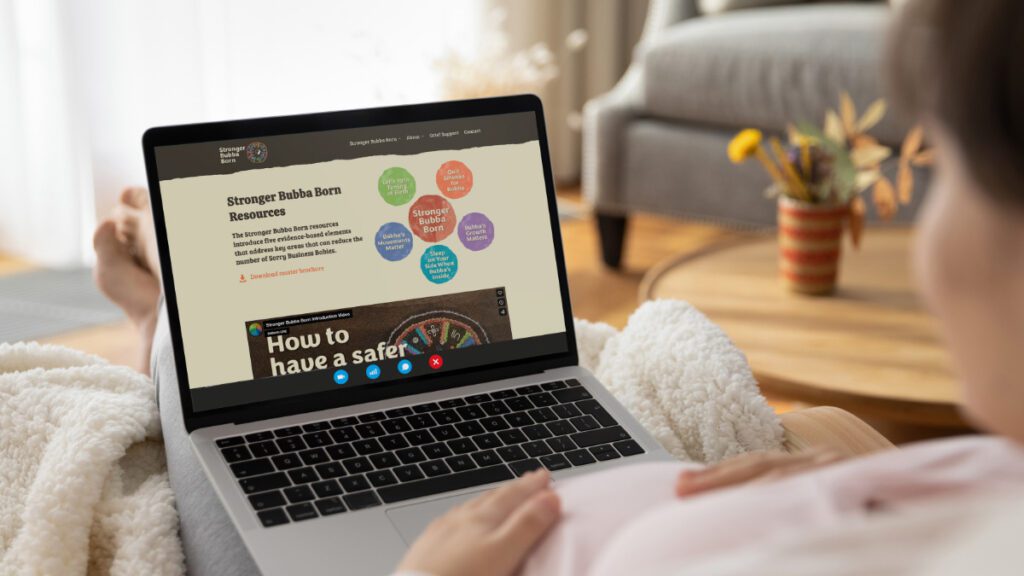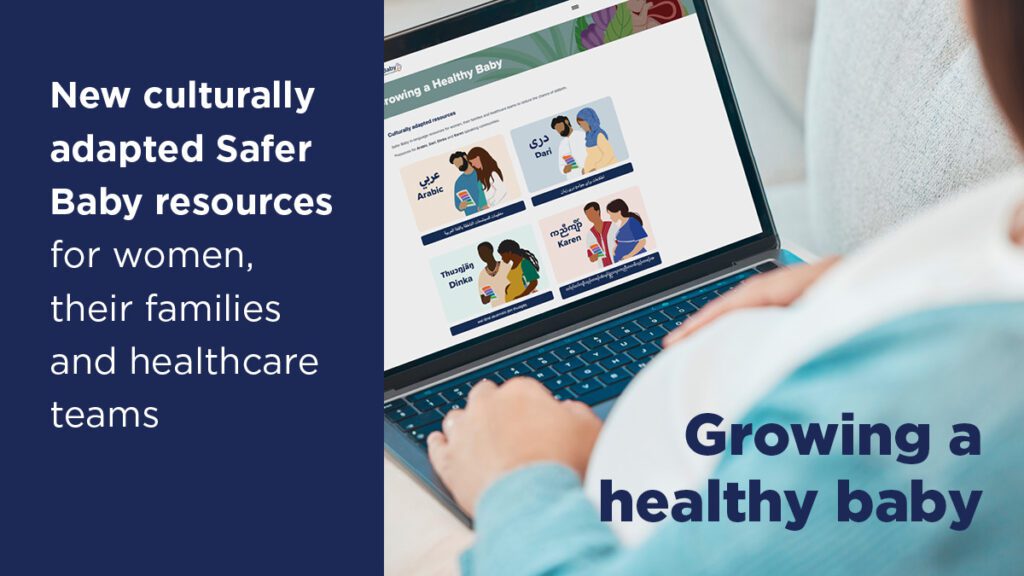About Us
Researchers + Clinicians
Parents

FIRST Nations women as well as migrant and refugee women from communities disproportionately impacted by stillbirth have been involved in co-designing new culturally appropriate pregnancy resources, to save the lives of babies in their own communities.
Stillbirth rates in Australia remain tragically high, with six babies stillborn on average, every day. A suite of sensitively-crafted, in-language resources, called ‘Stronger Bubba Born’ and ‘Growing a Healthy Baby’, have been developed from the evidence-based Safer Baby Bundle to improve maternity care for these communities and contribute to reducing stillbirth rates in Australia by 20 per cent.
It is believed between 20 and 30 per cent of late gestation stillbirths are preventable with better care, however systemic healthcare barriers can prevent important discussions about stillbirth prevention.
These new resources have been developed through extensive community consultation and input from health educators, to ensure the information and illustrations are culturally appropriate and reduce the devastating impact of stillbirth on these communities.
This important work has involved two years of consultation and development, and is an extension of the Safer Baby Bundle created by the Stillbirth Centre of Research Excellence (Stillbirth CRE).
The Mater Research-based Stillbirth Centre of Research Excellence Director, Professor Vicki Flenady, said “stillbirth rates are significantly higher among First Nations and some migrant and refugee communities, compared to the general population, and we need to tackle this by ensuring these communities have care and resources that meet their needs.”
“The Safer Baby Bundle is an evidence-based initiative designed to improve maternity care and drive down stillbirth rates in Australia, and we’ve already seen it work in Victoria. These new culturally sensitive resources, which have been carefully co-designed with the communities we are seeking to reach, will be central to the work we now need to do to reduce the burden of stillbirth among women at greatest risk,” Professor Flenady said.
Senior Advisor of Indigenous Research at Stillbirth CRE, Deanna Stuart-Butler said two years of consultation across Australia – from yarning circles to community and healthcare worker interviews – went into making sure evidence-based practice was implemented in First Nations communities’ own ways of “knowing, being and doing”.
“Without discounting the diversity across First Nations communities, these messages are presented in a lingo that our community speaks, understands and can relate to,” Ms Stuart-Butler said.
“Even though the clinical information is consistent with the mainstream Safer Baby Bundle messages, the way it has been presented also caters to our mob’s cultural considerations, which our team thought was very important for these resources to be accepted by the community.
“We hope that this two-pronged approach of targeting women as well as clinicians through evidence-based and culturally appropriate messaging on stillbirth prevention will help reduce the number of preventable stillbirths in our First Nations communities.”

About Stronger Bubba Born (resources for First Nations communities)
For First Nations women and their families to reduce the risk of Sorry Business Baby (stillbirth), the new Stronger Bubba Born resources include flyers and videos that are available at the Stronger Bubba Born website. These resources were developed by the Stillbirth CRE Indigenous research team with the guidance of the Indigenous Advisory Group. Delivery partner Curtin University supported the extensive consultation and co-design process. The National Aboriginal Community Controlled Health Organisation (NACCHO) and the Waminda South Coast Women’s Health and Wellbeing Aboriginal Corporation are also collaborators with the CRE on their Indigenous work.
Royal Australian and New Zealand College of Obstetricians and Gynaecologists (RANZCOG) board member and Multicultural Centre for Women’s Health board member Dr Nisha Khot said many migrants came from countries where routine pregnancy care, especially in early pregnancy, wasn’t the norm and these resources communicated the reasons for that care.
“In a lot of migrant communities, there’s a sense that bad outcomes can’t be prevented. Women may feel that a stillbirth might be their fault. It’s important to communicate that, no, this is something that can be prevented and these are the ways of preventing it,” Dr Khot said.
“Having this information in a language they can understand, discussed in a culturally sensitive way, can make a difference to the stillbirth rates because women themselves can take the preventative steps that we know work.”
Dr Fatima El-Assaad gave birth to her daughter Aya, who was stillborn, in 2021. She said she realised many bereaved parents were not aware that stillbirth could happen to them.
Dr El-Assaad said GPs and midwives could have discreet conversations about stillbirth while being open to understanding what the woman knew and felt about the topic, and then use the resources to extend those conversations in a respectful way.
“Some migrant and refugee communities, and First Nations communities, have the highest rates of stillbirth in our country. If we are committed to reducing the national stillbirth rates, it is essential that these communities can access culturally sensitive resources in a language they understand. Helping communities understand the steps to progressing a safer pregnancy may help to reduce the risk of preventable stillbirths. These resources will also help health professionals engage meaningfully with these women and provide culturally sensitive and competent care,” she said.

About Growing a Healthy Baby (migrant and refugee communities)
Arabic, Dari, Dinka and Karen-speaking communities now have access to important tailored information in the form of a written booklet, summary video and self-paced digital booklet with audio. These resources are now available at the Growing a Healthy Baby website. A network of community groups and health educators from the Multicultural Centre for Women’s Health (MCWH) and the Stronger Futures CRE at the Murdoch Children’s Research Institute (MCRI) worked with the Stillbirth CRE to develop these in-language resources.
New word for word translations in 25 languages
In addition, this latest information has also been translated into 25 languages and is available on the CRE’s Safer Baby website, saferbaby.org.au/, and available with all resources for healthcare professionals at learn.stillbirthcre.org.au/.
The five key areas covered in these new resources, and the Safer Baby Bundle, include:
The cultural adaptation of the Safer Baby Bundle has been funded by the Australian Government.
Contact the Stillbirth CRE team for more information via email stillbirthcre@mater.uq.edu.au.

Level 3, Aubigny Place
Mater Research Institute
Raymond Terrace,
South Brisbane QLD 4101
The University of Queensland Faculty of Medicine